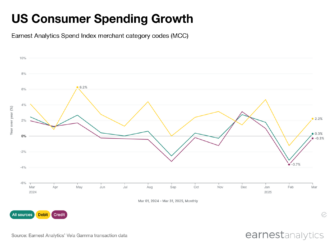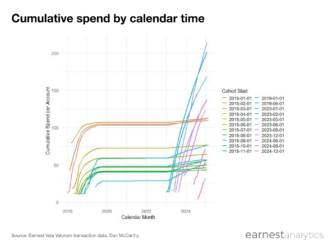Black Friday and Early Holiday Sales Reviewed
With many headlines lauding retail’s “record Black Friday performance”, we dove into the spending data of millions of de-identified US consumers in order to assess Black Friday and early Holiday sales, particularly in the context of this year’s shortened holiday period.
Our analysis is an overview of sales data to date* this season. We will be evaluating the full holiday performance after the New Year, including how the considerations (outlined below) may have affected this early period’s performance.
Key Takeaways
Performance
- Overall spending was indeed of record performance this season, with YoY growth accelerating 620bps to an unprecedented 11% YoY this Black Friday period. Amazon was the primary driver; the industry excluding Amazon accelerated 160bps to growth of 3.7% YoY.
- Walmart was the only big-box retailer to not see its growth accelerate and Amazon was the only large retailer to grow its market share, mostly at Walmart’s expense.
- Online sales growth at retailers excluding Amazon accelerated to 16% YoY, helping lift total spending for the entire industry. Best Buy saw diverging trends between its online and in-store channels, Kohl’s saw strong performance in both channels, and Walmart saw its online growth slow and repeated its in-store YoY declines.
Considerations
- The Shortened Holiday Season: It is likely that a significant amount of holiday shopping that would have otherwise been distributed across an additional 6 days was instead compressed into this year’s Black Friday / Cyber Monday period. This dynamic may have also had a more pronounced effect on e-commerce (read: Amazon) behavior: less time to shop in-store meant more shopping online.
- The First-of-the-Month Effect: Consumer spending tends to be higher surrounding the ~1st and ~15th of every month due to pay-period cycles. It is possible that some retailers benefited from the weekly shift this year, which moved Black Friday / Cyber Monday to the beginning of the month of December vs. its usual end-of-November time frame.
Record Performance; Amazon as the Catalyst
Spending as a whole grew an unprecedented 11% YoY this Black Friday period, a 620bp acceleration from its flattish performance last year. The primary catalyst was Amazon; the industry excluding Amazon accelerated 160bps from its 2% YoY growth last year.

Walmart Left Out of Big-Box Growth
Amazon, Best Buy, and Kohl’s saw their YoY growth accelerate ~10% to 15%. Target continued to accelerate its growth after a strong performance in 2018. Walmart was the only big-box retailer to not see its growth accelerate, continuing its roughly flat YoY performance over the past three years. The other 20 merchants** saw flattish trends after strong performance in 2018.

As a result, Amazon was the only big-box retailer to grow its market share between 2018 and 2019, primarily at the expense of Walmart.

The Online Lift
Looking at performance by channel, and excluding Amazon, online sales represented a sizeable piece of total spending, at 19%. Online growth of 16% YoY was stronger than last year’s 13% YoY, and helped lift total spending for the industry from its in-store growth of 1% YoY.

Best Buy and Kohl’s Shine; Target Solid
Looking at individual merchants, online growth accelerated at Target, Best Buy, and Kohl’s, and slowed at Walmart and the rest of the industry as a whole. Interestingly, Best Buy saw diverging trends between channels: online was incredibly strong after a weak 2018, while in-store continued to decline. Kohl’s saw strong performance in both channels, while Walmart saw the opposite.

Notes
*We define the “Black Friday Period” from Thanksgiving Day to the Monday 12 days later, which therefore includes early holiday sales. This ensures that all Black Friday / Cyber Monday transactions with processing delays are included in the analysis. (For reference, in 2017, the majority of Amazon’s Black Friday / Cyber Monday transactions were processed ~10 days after the important weekend). Additionally, a 12 day period also has the effect of mitigating some (but not all) of the compressed-season spending dynamic stated above.
**Analysis is based on the top 25 retailers in Earnest coverage, as a measure of panel sales, including (listed in descending order): Amazon, Walmart, Target, Best Buy, Kohl’s, and ‘Other 20 Merchants’: Macy’s, Dick’s Sporting Goods, Old Navy, Michaels, JCPenney, Nordstrom, TJ Maxx, Bath & Body Works, Ulta, Marshalls, Ross Stores, American Eagle, Dillard’s, Victoria’s Secret, Big Lots, Barnes & Noble, Gap, Lululemon, J.Crew, and Shutterfly.
Analysis excludes spend made on store-branded cards that will likely not be paid down until after the Black Friday period.











